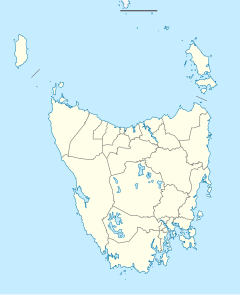South Bruny National Park
| South Bruny National Park | ||
|---|---|---|
|
|
||
| Location: | Tasmania , Australia | |
| Specialty: | Coastal landscape, birds | |
| Next city: | Kingston | |
| Surface: | 50.59 km² | |
| Founding: | 1997 | |
| Address: |
South Bruny National Park c / o Adventure Bay Post Office Bruny Island TAS 7150 |
|
The South Bruny National Park (English: South Bruny National Park ) is a national park on the southern tip of Bruny Island off Tasmania , Australia . The park includes the entire coastline, consisting largely of cliffs and part of the island's hinterland, as well as the Cape Bruny lighthouse . The highest point in the park is Mount Bruny at 504 meters.
Flora and fauna
Most of the park's vegetation consists of sparse eucalyptus forests and heathland. Only a small part consists of real forests and temperate rainforest . There are extensive stocks of kelp seaweed in the protected parts of the sea.
Wallabies , possums , short-billed hedgehogs and Tasmanian pademelons live in the park . Wombats and Tasmanian devils are not native here. Bruny Island is particularly well known for its albino wallabies, which have increased significantly on parts of the island due to the lack of enemies.
- Bird species in South Bruny National Park
All eleven bird species endemic to Tasmania are found in the national park . Fairy penguins , cap plover and the Sturmvogelart Puffinus tenuirostris breed on the coast, the sooty shearwater breeds on Courts Iceland. The tasman panther , one of the smallest and most critically endangered bird species in Australia, lives in the dry eucalyptus forests of Partidge Island .
You can also observe all three types of snake in Tasmania, the common tiger otter , the lowland copperhead and the white-lipped snake Drysdalia coronoides. Larger numbers of the South African fur seal can be observed on the coast of the Friars Islands .
Getting to the park and tourism
The park offers many opportunities for hiking. For example, you can see an old whaling station . There are swimming opportunities at Adventure Bay and Jetty Beach. The Cloudy Bay is, according to its name, more suitable for experienced surfers.
The Cape Bruny lighthouse , built by convicts in 1838, is an important testimony to the island's maritime history . It was the long-running lighthouse in Australia and is now a cultural monument that is under the administration of the national park.
See also
Individual evidence
- ↑ Explanations of the Park & Wildlife Service
- ↑ Information from the Park & Wildlife Service on the Tasman panther bird
- ↑ The Park Wildlife Service website on Tasmania's snakes
- ↑ Leaflet for visitors, pdf, engl.
- NN: Tasmania's Pristine South 2009 . Ed .: Houn Valley News, p. 28.
Web links
- official site of the park (Engl.)







